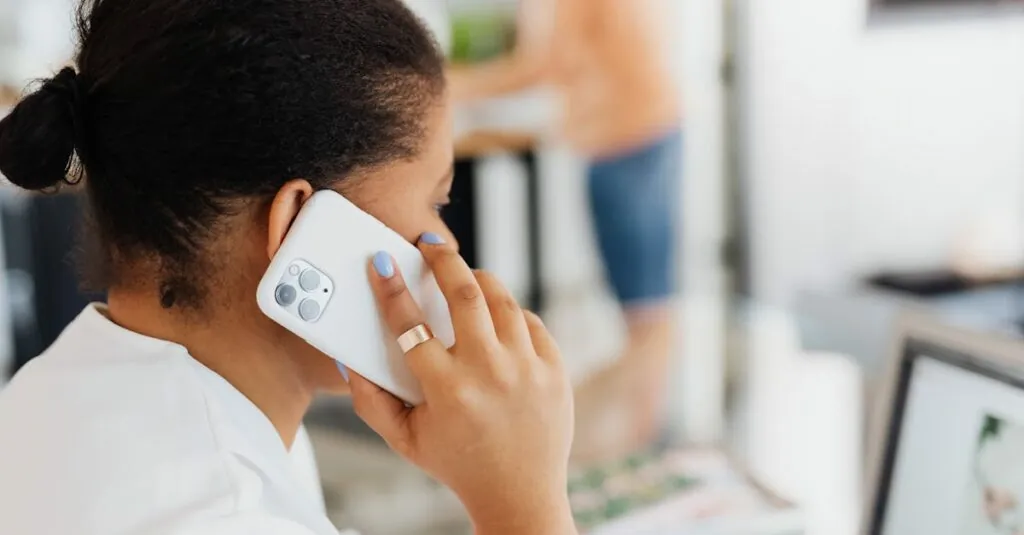Table of Contents
TogglePicture this: you’re eagerly waiting for that important call, but your iPhone decides to play hard to get. Frustrating, right? It’s like your phone’s suddenly taken a vow of silence and left you hanging. Whether it’s a glitch, a setting gone rogue, or just a case of “not today,” understanding why your iPhone isn’t accepting calls can save you from unnecessary panic.
Common Reasons Your iPhone Is Not Accepting Calls
Multiple factors can cause an iPhone to stop accepting calls. Understanding these common reasons helps in swiftly resolving the issue.
Network Issues
Weak or unstable network signals commonly prevent incoming calls. Check if the phone shows signal bars in the status bar. Outside interference or poor coverage can contribute to these problems. Moving to a different location might improve the signal strength. Sometimes, simply toggling mobile data off and on restores connectivity. Restarting the device can also refresh the network connection.
Do Not Disturb Mode
Do Not Disturb mode can silence all notifications, including calls. Look for the crescent moon icon in the status bar to see if this feature is enabled. Adjust settings in the Control Center or through the Settings app to disable it. Notifications from specific contacts can still come through with exceptions set in the Do Not Disturb menu. Understanding this feature allows users to manage their call experience more effectively.
Airplane Mode
Airplane Mode disables all wireless communications, preventing calls from coming through. Check if Airplane Mode is activated by viewing the status bar for the airplane icon. Turning off Airplane Mode usually resolves the issue quickly. This option can often be accessed from the Control Center. Turning it off restores normal functionality, allowing calls to come in as expected.
Software Problems
Software issues could prevent an iPhone from accepting calls. The following factors often contribute to this problem.
iOS Update Requirements
iOS updates sometimes include fixes for bugs affecting call functionality. Users must check for available updates in Settings under General, then Software Update. Regular updates ensure optimal performance and address known issues that could disrupt calls. Skipping updates can allow bugs to persist. If an update is available, downloading it often resolves various software-related problems.
App Conflicts
Third-party apps might interfere with call management on an iPhone. Some applications, particularly messaging or call-blocking apps, can affect how calls are received. It’s advisable to review app permissions and settings to rule out conflicts. Deleting or disabling problematic apps sometimes restores call functionality. Checking recent app updates can also help, as developers frequently release patches to improve compatibility with iOS.
Hardware Checks
Addressing hardware issues is crucial when an iPhone doesn’t accept calls. Users might need to conduct specific checks to identify potential problems.
SIM Card Issues
A damaged or improperly inserted SIM card can disrupt call functionality. Ensure the SIM card is securely seated in the tray without any debris. If the SIM card shows signs of wear, consider replacing it. Users can try placing the SIM card in another device to confirm whether it is functional. Additionally, checking for any carrier restrictions or outages is essential. Carrier settings might need updates to restore call capabilities.
Receiver Problems
Physical obstructions can hinder the receiver’s ability to connect calls. Inspect the microphone and speaker for dirt or damage. It’s important to keep these areas clean and free from blockages. Testing with another call can help determine if the issue lies within the device. Users should also check for any ongoing hardware faults that might necessitate professional repair. If other audio functions also malfunction, it indicates a broader hardware issue.
Troubleshooting Steps
Follow these troubleshooting steps to address the issue of an iPhone not accepting calls.
Restarting Your iPhone
Restarting an iPhone can resolve numerous glitches. To perform this action, press and hold the side button along with the volume button. Slide to power off once prompted. After the device shuts down completely, wait about 30 seconds before turning it back on. This simple action often resets temporary software issues that interfere with call functionality.
Resetting Network Settings
Resetting network settings can restore proper connectivity. Navigate to Settings, then tap on General, and select Transfer or Reset iPhone. From there, choose Reset Network Settings. This process restores Wi-Fi networks and passwords, along with cellular settings. Note that it doesn’t delete personal data but can resolve issues caused by incorrect settings. Reconnecting to Wi-Fi networks afterward is necessary for full functionality.
An iPhone not accepting calls can be a frustrating experience. By understanding the various factors that contribute to this issue users can take proactive steps to resolve it. From checking network connectivity to ensuring software is up to date troubleshooting becomes much easier.
Regular maintenance of both hardware and software can prevent many call-related problems. Keeping an eye on app permissions and settings also plays a crucial role. With the right approach users can restore their iPhone’s call functionality and enjoy seamless communication once again.







